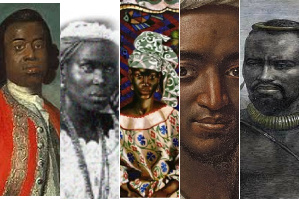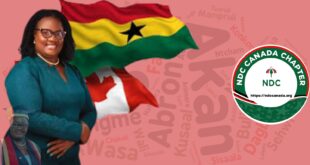Stories of slavery continue to come up at the top of the things that people want to know about the continent, its people, and its history.
And with no specific numbers ever available to refer to, there is no doubt that many millions of Africans were sold into slavery across the world.
But while it appeared the days of slavery were not properly regimented, there were a few not-to-dos, including the fact that people of royal lineages did not usually make the cut for those traded by the colonial masters.
However, like every narrative, there were some ‘buts’ and in this GhanaWeb feature, we take a look at some 5 royals who were also sold into slavery.
We begin with the story of a prince from Ghana:
William Ansah Sessarakoo.
William was sold into slavery by accident. This was after he was sent by his father, John Corrantee of Anomabo – a man well-known by African merchants because of his good working relationship with European leaders and the local workers, to school in France.
According to details available on slaveryandremembrance.org, Corrantee used his status as an intermediary and his diplomatic skills to gain a trade advantage over competing Europeans, and to strengthen their trade, he sent one of his sons, William Ansah Sessarakoo, to be educated in France.
At the time, Sessarakoo lived in the Cape Coast Castle with one of the officers of the Royal African Company.
While at the castle, William became an admirer of British culture and learned to speak and write in English.
In 1747, Sessarakoo boarded a slave ship, the Lady Carolina, which first took him to Barbados. There, the captain died, leaving Sessarakoo without a guide or anyone to verify his identity and legal status.
So, when it was time to depart for England, Sessarakoo boarded the wrong canoe and ended up enslaved in Barbados, instead of continuing on to his education in England.
Sessarakoo’s father, John Corrantee, thought his son had been kidnapped since it was a common practice of European slavers to take the sons of African leaders as hostages or pawns. After Corrantee demanded European officials investigate and return his son, a ship was sent to Barbados to retrieve Sessarakoo. The venture was successful. Sessarakoo’s freedom was restored, and he then sailed on to England.
The report added that when Sessarakoo arrived in London, he was treated as a celebrity and quickly became known as the Prince of Annamaboe.
His story of enslavement and rescue was preserved in forms of art, including drama, poetry, and painting. A portrait of William Ansah Sessarakoo was made, and etching of him appeared in The Gentlemen’s Magazine.
By 1750, Sessarakoo decided to return to Annamaboe, where he was warmly welcomed by his father.

Princess Anta Madjiguène Ndiaye of Senegal:
In 1806, at the public market in Rufisque, a coastal fishing village in Senegal, West Africa, a thirteen-year-old girl named Anta Madjiguène Ndiaye was sold as a slave to merchants from nearby Gorée Island.
Anta had been seized by warriors from a coastal nation who raided the Kingdom of Jolof in the interior of Senegal and marched their captives to Rufisque.
At Gorée Island, Anta was sold again to the captain of a European slave ship and carried across the Atlantic to Havana, Cuba, where she and two other teenage African girls were purchased by Zephaniah Kingsley, Jr., a ship captain and plantation owner from Spanish East Florida.
It is not known whether the warriors, island merchants, or the ship captains knew that Anta Madjiguène was a royal princess from the Kingdom of Jolof, the daughter of King Buri Nyabu and his wife Madjiguène, who were also descended from rulers of the kingdom.
Members of her own family and the residents of her home village knew only that Princess Anta had disappeared. More than two centuries would elapse before the residents of Senegal would learn from the book, Anna Madgigine Jai Kingsley: African Princess, Florida Slave, Plantation Slaveowner, that she survived her tragic ordeal, was emancipated by Kingsley, and became his principal wife and the mother of four children — and that she too became a land and slave owner.

Princess Aqualtune Ezgondidu Mahamud da Silva Santos of Central Africa:
Princess Mahamud was the daughter of an unknown King of Kongo. Kongo was located in modern-day northern Angola, the Republic of Congo, the western part of the Democratic Republic of the Congo and southern Gabon.
From 1891 to 1914, Kongo was a vassal state of Portugal.
After the Battle of Mbwila, the princess was transported to the Port of Recife, a warehouse and sugar mill.
It is documented that the princess was purchased solely for the purpose of reproduction with other slaves. When she became pregnant, the princess was sold to a mill in Porto Calvo, Brazil.
In her second to last month of pregnancy, the princess formulated the Palmares.
She later gave birth to Ganga Zone, Ganga Zumba, Sabina and Zona. Zumba was the first leader of the Palmares.
Thereafter, the whereabouts and fate of the princess are unknown.
It is reported that in 1665, Princess Aqualtune Ezgondidu Mahamud da Silva Santos led 10,000 men into the Battle of Mbwila; between the Kingdom of Kongo and the Kingdom of Portugal.
It is estimated that 5,000 men died in the war.
The surviving members of the Kongo army were captured and sold as slaves in Brazil amongst other places. Those captured included the King of Kongo, his two sons, his two nephews, four governors, various court officials, 95 workers in the kingdom and 400 other aristocrats.

King Takyi of Ghana:
Before finding himself as a slave, working hours on end and living in hard conditions on the Frontier plantation in Jamaica, Takyi was a Fanti king from Gold Coast, now modern Ghana.
There are no records of which group of Fantis he ruled over before becoming a slave but research indicates that he might have been the ruler of a settlement in Kommenda or Koromantse in the Central Region of Ghana.
Takyi was also a wealthy merchant and slave trader himself until he was captured during the Kommenda Wars and sold off into slavery when his state was defeated.
In 1759, after years of toiling and suffering on the plantations, Takyi and his allies, Yaw, Sobadu and Kwarteng, who were also of Ghanaian descent, escaped into a cave far beyond their plantations to plan a rebellion.
They escaped during the day when everyone was occupied with work or at night and returning before daybreak. With full support from Queen Nanny, Takyi’s plan was to defeat the British and all slave masters and create Jamaica as a separate and independent black colony.
Known as Takyi’s War or the 1760 Easter Rebellion of Port Maria, the rebellion took place a year later to become the second largest and most shocking rebellion 30 years after Breffu led the Akwamus in the 1733 St John slave insurrection. The massive Akwamu revolt is considered one of the longest lasting rebellion recorded in the history of the Americas.
In May of 1760, Takyi and his followers started the revolt in the early hours of the morning, starting at the plantation where they worked, killing the owners and thus freeing all the slaves.
The former slaves joined in the revolt immediately, and a few run off to spread the word of the revolt on other plantations. With a good number of followers, they quickly made their way to Fort Haldane, where Takyi killed the storekeeper and instructed his men to pick up all the machines and gunpowder they could get.
According to oral history, Takyi and his slaves were strengthened and protected by the Obeah spiritual leaders, who had been labelled witchdoctors by the westerners in Jamaica. The British commanded the Maroons and their local army to fight Takyi and his men as well as kill any Obeah leader.
The killing of an Obeah leader angered Takyi and his men, who by now had a strong army with close to 80 different groups and had taken control of a greater part of the land. Consequently, they killed several more plantation owners and white people before retreating into the bush to fight the Maroons sent by the white officials to stop the rebellion.
The rebellion lasted until July when Takyi was gunned down and killed. After he was shot, his head was cut and displayed in the centre of the town to indicate that the rebellion had been stopped and the freed slaves and Takyi’s army were now in danger.
Despite his death, Takyi’s military fought on hoping to realize his dream. Many slaves committed suicide to avoid capture and others were recaptured and sold off to different masters.
By the end of July 1760, the British had reinforced order and had conducted a mass unmarked burial for all the slaves killed during the war.
A waterfall close to the cave where Takyi and his men planned the revolt was named Tacky Falls and is currently open to visitors. A school has also been named after the great enslaved Ghanaian chief who led the rebellion.

Prince Ayuba Suleiman Diallo of Senegal:
A Muslim of high rank, Diallo was captured in 1730 on a trip to Gambia and sold to Stephen Pike, captain of the Arabella.
Diallo endured the Atlantic crossing aboard the Arabella and was one of 150 survivors who landed in Annapolis, Maryland, after a passage of nearly six months.

In Annapolis, he was purchased by a Mr. Tolsey, who employed him as a slave in the tobacco fields in Kent Island, Maryland.
Diallo escaped from the plantation and was captured and jailed.
While he was in jail, it was soon clear to those around him that Diallo was an educated and devout man who was a literate and strictly observant Muslim.
With the help of attorney Thomas Bluett of Maryland and James Oglethorpe, the founder of the colony of Georgia and Director of the Royal African Company in London, Diallo was freed.
It became clear later that his supporters in the Royal African Company had an ulterior motive in mind.
“The said Negroe understands and writes Arabick and may be of service to the company in giving him his freedom and sending him to Gambia,” a company employee insisted.

The company thus sent Diallo to England, where he was lionized in London society (he was even presented at Court), before he was finally allowed to return to Africa.
Five years after his initial enslavement in the Gambia, he stepped ashore a free man.
He was one of a very small handful of Africans who managed to return to their African homeland in the era of the Atlantic slave trade.
 Home Of Ghana News Ghana News, Entertainment And More
Home Of Ghana News Ghana News, Entertainment And More





